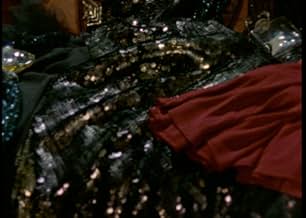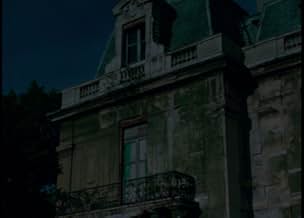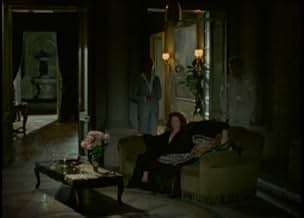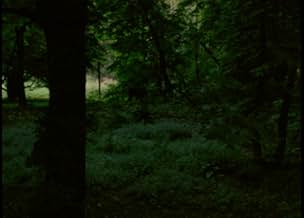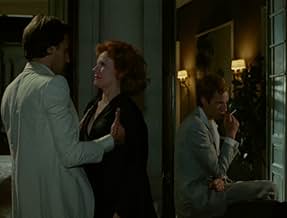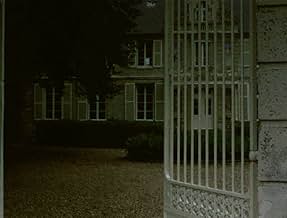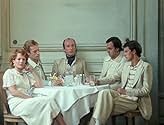CALIFICACIÓN DE IMDb
6.1/10
2.7 k
TU CALIFICACIÓN
Anne-Marie Stretter, esposa de un diplomático francés, vive en India en los años 30, donde tiene numerosos amantes. Varios sistemas de opresión se colapsan a su alrededor.Anne-Marie Stretter, esposa de un diplomático francés, vive en India en los años 30, donde tiene numerosos amantes. Varios sistemas de opresión se colapsan a su alrededor.Anne-Marie Stretter, esposa de un diplomático francés, vive en India en los años 30, donde tiene numerosos amantes. Varios sistemas de opresión se colapsan a su alrededor.
- Premios
- 3 nominaciones en total
Michael Lonsdale
- Le vice-consul de Lahore
- (as Michel Lonsdale)
Nicole-Lise Bernheim
- Voix de la réception
- (voz)
- (as Nicole Lise Bernheim)
- Dirección
- Guionista
- Todo el elenco y el equipo
- Producción, taquilla y más en IMDbPro
Argumento
¿Sabías que…?
- TriviaDominique Sanda was the first choice for the leading role, but dropped out and was replaced by Delphine Seyrig.
- ConexionesEdited into Passage des arts: Marguerite Duras, l'écriture et la vie (2021)
Opinión destacada
Once again Duras uses what she considers her great discovery in La femme du Gange, the timeless voices that comment with a certain independence on what is shown in the images.
Again Duras and her favorite characters: Anna-Marie Stretter, the vice consul, Michael Richardson, Lola V Stein...
Once again, a past story that comes to life before our eyes, told in a somewhat convoluted way, with jumps back and forth, with insistence on the same episodes, as in memories, but which becomes difficult to follow in all its implications if you do not know previously this little world created by Duras.
Now we have Anne-Marie Stretter back in Calcutta, to the palace of her ambassador husband, dragging behind her that Michael Richardson who has abandoned Lola Valerie Stein in S Thala. Back in Calcutta, Anna continues to lead a promiscuous life in total agreement with her husband, and now with a more or less official lover, Michael Richardson. During a reception, she is introduced to the outlawed former consul in Lahore.
Again the voices narrating, although not exactly, what we see in the images. In this case Duras creates a more complex soundtrack, a mix of timeless voices, the leprous beggar from Savannakhet, society voices at a reception for the ambassador, the author herself in dialogue, and finally the dialogues of the characters themselves that we see dancing without moving their lips...
The images show an essential illustration, sometimes reduced to its fundamental gestures, and languidly dedramatized, a kind of setting in style of what we are told, completely devoid of blood, in endless dances, glances at the voice-over space, or pantomimes of some especially important scenes.
Most of it takes place during a reception for the ambassador, Anna Marie's husband, but what we see in the images is an idealized recreation, where the environment disappears and only remain the disembodied voices of the attendees and a small space of a room, duplicated by a huge wall mirror and overlooking the terrace.
The characters wander through it, dancing while their off-screen voices slowly pronounce their dialogues, while the characters we see refuse us those dialogues on their lips and only contextualize them in glances. It is a past that is shown to us as the images that summarize it in our memory or dreams.
Delphine Seyring is magnificent and beautiful as the focus of attention, the dissatisfied and capricious woman who attracts all the men around her. To announce her story as a woman subjected to various systems of oppression, it seems to us that she enjoys quite a few freedoms, if she simply decided to make a decision. Delphine looks wistfully out the window of the luxurious hotel, aware of life out there, and of life in her Venice past, but unable to break her bonds. Leprosy...
Michael Lonsdale as the former vice-consul, deeply ridiculous, with teary eyes, avoided by everyone because of a previous scandal in Lahore, in love with the protagonist and feared by her as if it were a Jack the Ripper in a tuxedo. He has to pronounce phrases like "Lahore, c'est moi", which is not easy for him either. This self-destructive and crazed guy proposes to Anne-Marie a scandal during the evening, which seems to be the only thing that can breathe some life and passion into this environment of mannequins.
We are not very sure of the authenticity of the love between Michael and Anne-Marie, of course Michael likes to caress Anne's red hair, which we know is a wig, but something must not be going very well, it definitely tastes too little for both of them. , and we learn that they have tried to commit suicide before in a brothel room.
Mathieu Carrière is another young man who seems to want to join Anna's list of lovers. All we can say about him is that he is a awfully bad dancer.
After the disastrous reception, we have Anna in her red party dress, reclining in a chair and surrounded by her lovers in their evening tuxedos. All of enormous theatricality while Duras tells us about the lady's destiny, her trip to the islands, the flora, fauna, landscape and population of the area, generally answering a man's questions in a strange dialogue in which sometimes it seems that Duras is guiding him through a story and images that she creates little by little, answering his questions... until in the end the man seems capable of accompanying Duras in continuing to tell the story.
In the next scene we have Anna arriving with her boys at the "White India" Hotel, the Prince of Wales. We see her walking down the luxurious hallway with a distant smile. And the ex consul appears again.
In the last scene, the characters seem tired of their erotic stories, and their menage-a-trois, and decide to end the situation.
The tone is desperately and exquisitely kitsch, of a sought-after artificiality, of great formal beauty that is somewhat repugnant. Technically it is much more sophisticated than the more authentic La femme du Gange; the images here revel in the luxurious interiors, in the texture of the dresses and curtains, in the beauty of the nights in the gardens surrounding the ambassador's palace, the sophisticated interiors of luxury hotels, in the body of Anne-Marie Stretter languid with desire, dissatisfaction and heat.
The voices, as always, remember or discover the story with their Oui, cest ca, je me rappelle... the usual taglines of Duras' recitations.
The music alternates the danceable India Song with a very languide playing of one of Beethoven's Diabelli variations.
Another emotional zombie film, with a suffocating luxury atmosphere, of a small group of privileged people obsessed with their navel, and enjoying without enjoying their rich people's paradise, while out there it is 1937, the war continues in China, Shanghai bombed, the Spanish civil war, the Nuremberg Congress... the voice of the beggar from Savannakhet.
The film can seem laughable and ridiculous or fascinating, or at times one thing and the other, or both at the same time. But we cannot deny that it is one of Duras's most notable works, within her very special conception of narrative. Based on a play that was never performed.
Again Duras and her favorite characters: Anna-Marie Stretter, the vice consul, Michael Richardson, Lola V Stein...
Once again, a past story that comes to life before our eyes, told in a somewhat convoluted way, with jumps back and forth, with insistence on the same episodes, as in memories, but which becomes difficult to follow in all its implications if you do not know previously this little world created by Duras.
Now we have Anne-Marie Stretter back in Calcutta, to the palace of her ambassador husband, dragging behind her that Michael Richardson who has abandoned Lola Valerie Stein in S Thala. Back in Calcutta, Anna continues to lead a promiscuous life in total agreement with her husband, and now with a more or less official lover, Michael Richardson. During a reception, she is introduced to the outlawed former consul in Lahore.
Again the voices narrating, although not exactly, what we see in the images. In this case Duras creates a more complex soundtrack, a mix of timeless voices, the leprous beggar from Savannakhet, society voices at a reception for the ambassador, the author herself in dialogue, and finally the dialogues of the characters themselves that we see dancing without moving their lips...
The images show an essential illustration, sometimes reduced to its fundamental gestures, and languidly dedramatized, a kind of setting in style of what we are told, completely devoid of blood, in endless dances, glances at the voice-over space, or pantomimes of some especially important scenes.
Most of it takes place during a reception for the ambassador, Anna Marie's husband, but what we see in the images is an idealized recreation, where the environment disappears and only remain the disembodied voices of the attendees and a small space of a room, duplicated by a huge wall mirror and overlooking the terrace.
The characters wander through it, dancing while their off-screen voices slowly pronounce their dialogues, while the characters we see refuse us those dialogues on their lips and only contextualize them in glances. It is a past that is shown to us as the images that summarize it in our memory or dreams.
Delphine Seyring is magnificent and beautiful as the focus of attention, the dissatisfied and capricious woman who attracts all the men around her. To announce her story as a woman subjected to various systems of oppression, it seems to us that she enjoys quite a few freedoms, if she simply decided to make a decision. Delphine looks wistfully out the window of the luxurious hotel, aware of life out there, and of life in her Venice past, but unable to break her bonds. Leprosy...
Michael Lonsdale as the former vice-consul, deeply ridiculous, with teary eyes, avoided by everyone because of a previous scandal in Lahore, in love with the protagonist and feared by her as if it were a Jack the Ripper in a tuxedo. He has to pronounce phrases like "Lahore, c'est moi", which is not easy for him either. This self-destructive and crazed guy proposes to Anne-Marie a scandal during the evening, which seems to be the only thing that can breathe some life and passion into this environment of mannequins.
We are not very sure of the authenticity of the love between Michael and Anne-Marie, of course Michael likes to caress Anne's red hair, which we know is a wig, but something must not be going very well, it definitely tastes too little for both of them. , and we learn that they have tried to commit suicide before in a brothel room.
Mathieu Carrière is another young man who seems to want to join Anna's list of lovers. All we can say about him is that he is a awfully bad dancer.
After the disastrous reception, we have Anna in her red party dress, reclining in a chair and surrounded by her lovers in their evening tuxedos. All of enormous theatricality while Duras tells us about the lady's destiny, her trip to the islands, the flora, fauna, landscape and population of the area, generally answering a man's questions in a strange dialogue in which sometimes it seems that Duras is guiding him through a story and images that she creates little by little, answering his questions... until in the end the man seems capable of accompanying Duras in continuing to tell the story.
In the next scene we have Anna arriving with her boys at the "White India" Hotel, the Prince of Wales. We see her walking down the luxurious hallway with a distant smile. And the ex consul appears again.
In the last scene, the characters seem tired of their erotic stories, and their menage-a-trois, and decide to end the situation.
The tone is desperately and exquisitely kitsch, of a sought-after artificiality, of great formal beauty that is somewhat repugnant. Technically it is much more sophisticated than the more authentic La femme du Gange; the images here revel in the luxurious interiors, in the texture of the dresses and curtains, in the beauty of the nights in the gardens surrounding the ambassador's palace, the sophisticated interiors of luxury hotels, in the body of Anne-Marie Stretter languid with desire, dissatisfaction and heat.
The voices, as always, remember or discover the story with their Oui, cest ca, je me rappelle... the usual taglines of Duras' recitations.
The music alternates the danceable India Song with a very languide playing of one of Beethoven's Diabelli variations.
Another emotional zombie film, with a suffocating luxury atmosphere, of a small group of privileged people obsessed with their navel, and enjoying without enjoying their rich people's paradise, while out there it is 1937, the war continues in China, Shanghai bombed, the Spanish civil war, the Nuremberg Congress... the voice of the beggar from Savannakhet.
The film can seem laughable and ridiculous or fascinating, or at times one thing and the other, or both at the same time. But we cannot deny that it is one of Duras's most notable works, within her very special conception of narrative. Based on a play that was never performed.
- Falkner1976
- 15 abr 2024
- Enlace permanente
Selecciones populares
Inicia sesión para calificar y agrega a la lista de videos para obtener recomendaciones personalizadas
- How long is India Song?Con tecnología de Alexa
Detalles
- Fecha de lanzamiento
- País de origen
- Sitio oficial
- Idioma
- También se conoce como
- 印度之歌
- Locaciones de filmación
- Productoras
- Ver más créditos de la compañía en IMDbPro
Taquilla
- Presupuesto
- FRF 254,542 (estimado)
- Total a nivel mundial
- USD 9,308
Contribuir a esta página
Sugiere una edición o agrega el contenido que falta

Principales brechas de datos
What is the Italian language plot outline for India Song (1975)?
Responda

